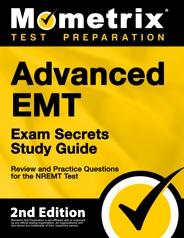To become a certified Advanced Emergency Medical Technician (AEMT), you first need to complete the AEMT exam. This is a knowledge-based test that measures your understanding of the principles and practices of working as an AEMT.
Click “Start Test” above to take a free AEMT practice test!
AEMT Exam Eligibility
To be eligible to take the Advanced EMT exam, you must meet the following requirements:
- You must be at least 18 years old
- You must hold a license from your state at the EMT level (or higher)
- You must complete a state-approved AEMT course of study that either meets or exceeds the National Emergency Medical Services Education Standards for the Advanced Emergency Medical Technician
- You must have a current CPR-BLS Healthcare Provider or equivalent credential
AEMT Exam Outline
The AEMT exam was previously split into two exams, a cognitive exam and a psychomotor exam, both of which had to be passed in order to pass the full AEMT exam. As of July 2024, the psychomotor exam has been phased out entirely.
The exam contains 135 multiple-choice questions, 35 of which are unscored, and you will be given a time limit of 3 hours. The 35 unscored questions are used to evaluate questions for future versions of the exam. They are unmarked, so you will not know which questions are scored and which are unscored.
The exam is split into six content areas:
| Content Area | Percent of Exam |
|---|---|
| Airway, Respiration, and Ventilation | 9%-13% |
| Cardiology and Resuscitation | 11%–15% |
| Trauma | 7%–11% |
| Medical/Obstetrics/Gynecology | 25%–29% |
| EMS Operations | 6%–10% |
| Clinical Judgment | 31%–35% |
Check Out Mometrix's Advanced EMT Study Guide
Get practice questions, video tutorials, and detailed study lessons
Get Your Study Guide
Registration
To register for the AEMT exam, you must submit an application to NREMT. Once your application is reviewed, you will receive an authorization to test (ATT). At the time of application, you must submit the $159 application fee.
Test Day
You should arrive at the testing center 30 minutes before your exam appointment. The facilitator will verify your ID and take your photo and digital signature. Your digital signature must match the signature on your ID.
Once the check-in process is complete, you will be asked to place all personal items in a secure locker outside the testing room, or in your car.
The proctor will then lead you to the testing area and provide information on how the exam process works.
You can take breaks as needed, but know that your time on break counts against your allotted testing time. If you do take a break during your exam, you cannot refer to any reference materials or use your mobile device.
Exam Scores
The AEMT exam is scored using a scaled system. This system takes your raw score, which is the number of questions you answered correctly, and converts it to a score that fits on a numerical scale of 100-1,500.
To pass, you will need to achieve a scaled score of at least 950. For every version of the AEMT exam, the number of questions that must be answered correctly to get a score of 950 can vary.
Your score and results of whether you passed the exam will be posted on your online account within two business days after you take the exam.
Retaking the Exam
If you fail the exam, you may submit an application to retake it 15 days after your first attempt.
Check Out Mometrix's Advanced EMT Flashcards
Get complex subjects broken down into easily understandable concepts
Get Your Flashcards
FAQs
Q
How many questions are on the AEMT exam?
A
There are 135 multiple-choice questions on the exam.
Q
How long is the AEMT exam?
A
The time limit for the exam is 3 hours.
Q
How much does the AEMT exam cost?
A
The application fee for the exam is $159.
